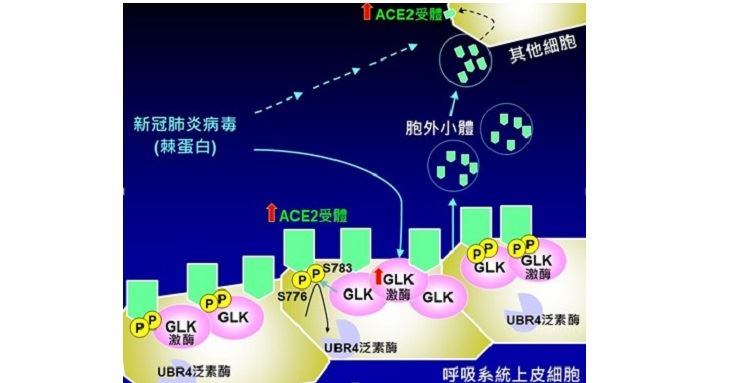It has been more than two years since the outbreak of the new coronary pneumonia epidemic, which has spread globally, causing up to 580 million infections and more than 6 million deaths. spike protein, S protein) binds to the ACE2 receptor on the surface of human respiratory epithelial cells to infect cells. However, normal epithelial cells actually only express low levels of ACE2 protein, but they can quickly induce acute and severe respiratory symptoms after infection. The mechanism of its rapid spread has the opportunity to find methods and strategies to reduce the infection.
New discovery by the National Institute of Health: New coronavirus regulates a new mechanism for rapid cell infection! Favorable drug and vaccine development. (Photo provided / National Health Service)
–
The research team of Tan Zehua Distinguished Researcher and Assistant Researcher Zhuang Huaijia of the Center for Immunology of the National Institutes of Health found that the expression of protein kinase MAP4K3 (also known as GLK) in cells infected with the new coronavirus is higher than that in normal cells, and the proportion of epithelial cells with high expression of GLK is related to disease Severity is positively correlated, and in cooperation with researcher Zhou Yanhong from the Institute of Infectious Diseases and Vaccines of the National Health Service, the use of live new coronavirus mouse experiments confirmed that this infection mechanism is the key to the substantial infection of the new coronavirus, and can also explain the mechanism of the side effects caused by the new coronavirus vaccine . The research results will be published in the world-renowned medical journal “EMBO Molecular Medicine” in July 2022.
The research team analyzed the single-cell RNA sequencing results of COVID-19 patient samples and unexpectedly found that after the new coronavirus entered the host epithelial cells, the spike protein would induce high expression of the protein kinase GLK. Continued use of proteomics and various biochemical experiments confirmed that overexpressed GLK phosphorylates ACE2 protein, allowing ACE2 to escape the ubiquitination degradation mechanism of ubiquitinase UBR4, resulting in a stable increase of ACE2 protein on the cell surface. At the same time, the overexpression of GLK induces the release of exosomes loaded with ACE2 protein, which are transmitted to other cells with low ACE2 expression. These cells that have received ACE2 protein are more likely to be infected by the new coronavirus. The researchers analyzed the serum samples of COVID-19 patients and found that GLK phosphorylated ACE2 protein and exosomes loaded with ACE2 protein increased significantly compared with normal samples. These research results confirm that the excess expression of protein kinase GLK is a key factor in the pathogenesis of COVID-19, and also explain the reason why the new coronavirus quickly induces clinical symptoms and is easy to spread.
The research team used the mouse model to conduct animal experiments. When the small molecule inhibitor of GLK (verteporfin) was used to reduce the amount of ACE2 protein on the cell surface and reduce the production of ACE2 exosomes, the infection rate of the new coronary pneumonia virus in mice was successfully suppressed. . Verteporfin and other drugs that can modulate GLK and ACE2 have the potential to be candidate drugs for inhibiting new coronavirus infection.
In addition, the research results can further explain the mechanism of severe inflammatory response caused by new coronary pneumonia and the side effects of new coronary pneumonia vaccine. The main component of the new coronary pneumonia vaccine is spike protein or spike protein RNA. Spike protein may also stimulate and induce immune cells to produce excessive GLK, resulting in a strong inflammatory response and side effects of the vaccine. It is expected that by further unraveling the pathogenic mechanism of the disease, it will help the research and development and screening of therapeutic drugs and vaccines, develop novel medical methods for relieving disease symptoms, and promote the well-being of all people.
–

/data/photo/2022/08/03/62e970d5e96f8.jpg)
